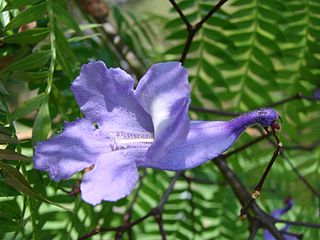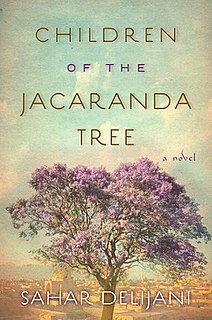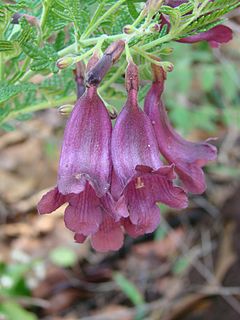
The Brazil nut is a South American tree in the family Lecythidaceae, and it is also the name of the tree's commercially harvested edible seeds. It is one of the largest and longest-lived trees in the Amazon rainforest. The fruit and its nutshell – containing the edible Brazil nut – are relatively large, possibly weighing as much as 2 kg in total weight. As food, Brazil nuts are notable for diverse content of micronutrients, especially a high amount of selenium. The wood of the Brazil nut tree is prized for its quality in carpentry, flooring, and heavy construction.

Dalbergia is a large genus of small to medium-size trees, shrubs and lianas in the pea family, Fabaceae, subfamily Faboideae. It was recently assigned to the informal monophyletic Dalbergia clade : the Dalbergieae. The genus has a wide distribution, native to the tropical regions of Central and South America, Africa, Madagascar and southern Asia.

Jacaranda is a genus of 49 species of flowering plants in the family Bignoniaceae, native to tropical and subtropical regions of the Americas.

Jacaranda mimosifolia is a sub-tropical tree native to south-central South America that has been widely planted elsewhere because of its attractive and long-lasting violet-colored flowers. It is also known as the jacaranda, blue jacaranda, black poui, or fern tree. Older sources call it J. acutifolia, but it is nowadays more usually classified as J. mimosifolia. In scientific usage, the name "jacaranda" refers to the genus Jacaranda, which has many other members, but in horticultural and everyday usage, it nearly always means the blue jacaranda.

Manduca muscosa, the muscosa sphinx, is a moth of the family Sphingidae.

Dalbergia nigra, commonly known as the Bahia rosewood, jacarandá-da-Bahia, Brazilian rosewood, Rio rosewood, jacarandá-do-brasil, pianowood, caviúna, graúna, jacarandá-una or obuina is a species of legume in the family Fabaceae.

Machaerium villosum, the jacarandá-do-cerrado, jacarandá-pardo, jacarandá-paulista, or jacarandá-pedra, is a species of legume in the family Fabaceae. It is found only in Brazil. It is threatened by habitat loss.

Brazil once had the highest deforestation rate in the world and in 2005 still had the largest area of forest removed annually. Since 1970, over 700,000 square kilometres (270,000 sq mi) of the Amazon rainforest have been destroyed. In 2012, the Amazon was approximately 5,400,000 square kilometres (2,100,000 sq mi), which is only 87% of the Amazon's original size.
The Saint and The Sow is a very popular Brazilian play written by Ariano Suassuna that was first published in 1957. The play, according to Suassuna, is a "Northeastern imitation" from the play Aulularia, from the Roman writer Plautus.

Irará is a city in Bahia, Brazil. The municipality is the hometown of former professional footballer Dida, of A.C. Milan and Brazil national football team fame and musician Tom Zé.

Dalbergia cearensis, with common names Brazilian kingwood, kingwood, Bois de Violette, and violetwood, is a small tree endemic to Brazil.
Bela Vista da Caroba is a municipality in the state of Paraná in the Southern Region of Brazil.

Children of the Jacaranda Tree is the internationally acclaimed debut novel of Iranian writer Sahar Delijani. Partially inspired by the writer's family history, it is a story about one of the worst best kept secrets of post-revolutionary Iran: the 1988 executions of Iranian political prisoners. The novel depicts not only the lives of the victims but also those of their families and above all their children. The novel is a poignant attempt at describing the genesis of a dictatorship, how it begins, how it affects a people, and what it means to resist it.
Jacaranda copaia is a flowering pioneer tree belonging to the genus Jacaranda. It is native to Central America, and Northern and Western parts of South America.

The jacaranda was a historically significant specimen of Jacaranda mimosifolia tree that stood in the south-eastern corner of the University of Sydney main quadrangle, and now describes its clone replanted in the same location.
Jacaranda is a genus for 49 different species of flowering plants.

Jacaranda caucana is a species of flowering tree first described by Swiss-born botanist Henri François Pittier in 1917. It is native to Costa Rica, Panama, the Dominican Republic, Venezuela and Colombia.

Jacaranda ulei is a flowering tree native to the Cerrado region of Brazil. It was first described by Édouard Bureau and Karl Moritz Schumann in 1897.
Jacaranda micrantha is a species of tree in the family Bignoniaceae.














